Quang Nam
Quang Nam is located in the middle of Central Viet Nam and is surrounded by Da Nang City, Thua Thien-Hue, Quang Ngai, and Kon Tum provinces. The Truong Son Mountains, Laos, and the East Sea also border the province.
Quang Nam has various of mountains and hills (covers 72% its surface) with many high mountains such as Lum Heo Mountain of 2,045m, Tion Mountain of 2,032m, Gole- Lang Mountain of 1,855m... Main rivers run from Truong Son Range to East Sea as Vu Gia , Thu Bon, Tam Ky rivers.
Experiencing the ups and downs over the years, Quang Nam still preserves the unique historical and cultural remains of the past along with rich human values. Some of the typical cultural sites include: Hoi An Ancient Town, My Son Holy Land, Tra Kieu Old Champa Capital, Cham Towers in Khuong My and Chien Dan, which record the remains of Sa Huynh, Champa and the Dai Viet civilization.
Tourist destinations in Quang Nam
1. Hoi An Ancient Town
Hoi An is an old town down the Thu Bon River, on the coastal plain of Quang Nam Province, about 30 km south of Da Nang City. Hoi An used to be known on the international market with many different names such as Lam Ap, Faifo, Hoai Pho and Hoi An.
What is so special about Hoi An is that this little port town is in an incredible state of preservation. It offers some of the most densely-concentrated sights in Viet Nam with its old streets bordered with ancient houses and assembly halls, its pagodas, temples, ancient wells and tombs. In total, more than a thousand places of interest. The architecture of Hoi An is characterised by a harmonious blend of Vietnamese, Chinese and Japanese influences. After many centuries, Hoi An is still respectful of its traditions, folk festivals, beliefs and of its sophisticated culinary art. Set in a quiet environment, Hoi An is surrounded by peaceful villages that have crafts such as carpentry, bronze making, ceramic...
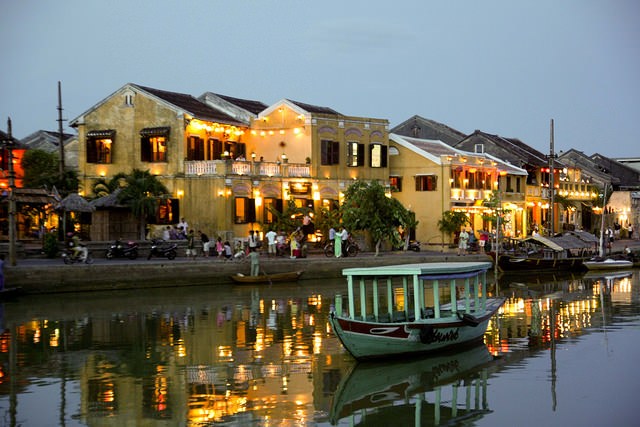 Photo: vietnamholiday.com
Photo: vietnamholiday.com
For centuries, Hoi An had developed into a melting pot of various nationalities who came to the area, bringing along their own cultures. Accordingly, Hoi An features the co-existence of indigenous customs and habits and those imported by foreign settlers.
2. My Son Holy Land
My Son Holy land - a unique beautiful sanctuary world of the ancient Cham religion, is day by day attracting thousands of tourists elsewhere!
Chăm Pa culture had great influences on Vietnam’s cultural values of significance. The once capital of Champa Kingdom from 4th to 15th century was “Thánh địa Mỹ Sơn”, called “My Son Sanctuary" or "Valley of Kings" by French historians.
Photo: govietnam.info
In those days, My Son became centre for spirituality and worship during the reign of the Champa Kingdom. Exemplifying the height of Chăm architectural achievement, The My Son Sanctuary is a large complex of religious monuments originally consisting of more than 70 structures; the vestiges of 25 of which remain today. The builders of My Son were the nobility of the Champa Kingdom who derived their cultural and spiritual influences almost exclusively from India.
Honorably recognized as a World Heritage in 1999, My Son Holy Land is captivating in various cultural values. Therefore, it is extremely useful and meaningful for those interested in Southeast Ahsian culture, which owes its core to ancient Cham culture, to drop off the land. Although time and the wars have destroyed some towers, the remaining sculptural and architectural remnants still reflect the style and history of the art of the Cham people. Their masterpieces mark a glorious time for the architecture and culture of the Cham, as well as of Southeast Asia.
3. Cu Lao Cham
Cu Lao Cham (Cham Islands), a World Biosphere Reserve in Quang Nam Province is famous not only for its wild beauty but also for being an area which has drawn the special attention of scientists because it possesses species of corals first found in Vietnam. The successful cultivation and restoration of the coral reefs in this area have opened a new research direction to restore the damaged coral reefs in the waters of Vietnam.

Photo: dattour.com.vn
4. Beaches in Quang Nam
Quang Nam province has 125 kilometers of coast line from Dien Ngoc (Non Nuoc beach) to Dung Quat Bay (Quang Ngai province) with beautiful and clean beaches: Ha My, Cua Dai, Binh Minh, Tam Thanh, Ky Ha, Bai Rang. Most of the beaches in Quang Nam have white sandbanks, blue shallow water and average salt content. On good weather nights, the water surface is twinkling by the plentiful neon lights from many fishing-boats like beautiful lantern cities in the sea.
Quang Nam attracts tourists by the variety of sea-foods such as fish, crab, shrimp, cuttle-fish, etc because their tastes seem to be more delicious than any other places.
Some famous beaches are as the followings:
-
Ha My beach: Dien Duong commune - Dien Ban district, 6 km South of Ngu Hanh Son (Marble mountain) in Da Nang city.
-
Cua Dai beach: Cua Dai ward - Hoi An city, 4 km East of the center of Hoi An.
-
Binh Minh beach : Binh Minh commune - Thang Binh district, about 15 km east of Ha Lam town
-
Tam Thanh beach : Tam Thanh commune - Tam Ky city, 7 km East of the center of Tam Ky city.
Cua Dai Beach: abay.vn
5. Ban Than Peak
Along the coast line of Quang Nam with blue water and white sand, there suddenly emergs a black rock cliff heaping up like coal, it is 2 kilometers in length and 40 metres high, combined with a stone edge to make a unique natural sculpture. From the top of Ban Than, tourists can look out over the vast area of sea, with Cham island and Ong Island in the long distance. Mingling between sea and sky, Binh Than is tottery and create dizzy feeling. Ban Than tow is a beautiful landscape for men who like risky adventure and discovering grandiose nature.
Ban Than beautiful spot - Photo: vietnamoi.vn
6. Thu Bon River
Originating from Ngoc Linh mountaintop of 2598 meters high, the Thu Bon, at its beginning, is just a small river flowing silently throughout the stone edges in the west of Quang Nam. Thanks to increasing water output from Tien, Tranh rivers in the area of Tra My and Tien Phuoc districts, Thu Bon river had raised alluvial soil for Que Son, Dai Loc and Duy Xuyen lands. From here, Thu Bon and Vu Gia rivers join together before splitting in two somewhere in Dien Ban: the northern is the main river called Thu Bon (another name Cho Cui river), the southern is the smaller branch called Ba Ren. Close to the sea, Thu Bon and Ba Ren rivers join up with the Truong Giang river which passes through Hoi An ancient town and ends up in the Cua Dai sea.
Thu Bon River - Photo: baodongnai.com.vn
On a boat trip down Thu Bon river, tourists will pass through many reputed villages known for their breeding of silkworms and famous landscapes such as the Hon Kem Da Dung, Nong Son coal mine, and Dai Binh tree and fruit villages. Stopping in river wharf, tourists can participate in the countryside market place, enjoy the sweet ho-heave-ho melody, listen to story about Puong Chao, Bo Bo Madam and study the legend of Thu Bon River in the war of national defense.
7. Hon Kem - Da Dung Landscape
Beautiful and poetic, Hon Kem is located in the area of Que Lam and Que Phuoc commune, Que Son district. Thu Bon River widens here to creat a deep large lake. At sunrise and sunset, a mist spreads across the water creating a magical scenery.
“ Ngo len Hon Kem Da Dung
Thuong cha nho me qua chung, bau oi!”
“ As raising up Hon Kem Da Dung
Oh! How much I miss my mum and dad!”
Hon Kem Da Dung is has inspired many poems, music, and pictures of the Vietnamese people and is the pride of Quang Nam.
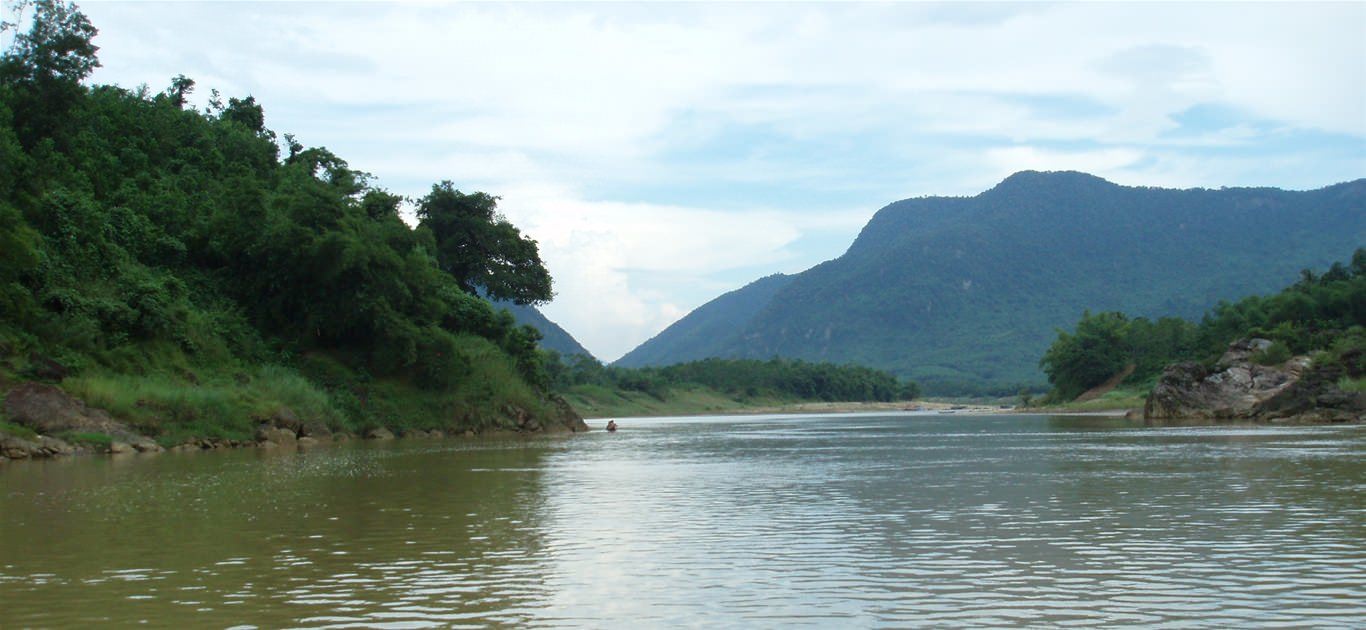
Hon Kem Da Dung Landscape - Photo: vi.wikipedia.org
Hon Kem Da Dung is the location of the insurgent army base of the province chief Nguyen Duy Hieu (Nguyen’s dynasty) and the base of the national hero Hoang Van Thu in the struggle against French colonialists.
Hon Kem Da Dung not only attracts tourists by its beautiful and poetic landscape but also by many secret ancient words of the Cham people carved on the sheer rocks of tens of tons in weight reflected in Thu Bon river.
8. Phu Ninh Reservoir
7 kilometres West of Tam Ky, Phu Ninh Reservoir is an irrigation works with capacity for about half of billion cubic metres of water and a surface of 3.433 hectares. This work was started in 1977 and finished ten years later. Apart from the advantages for developing irrigation, aquiculture, power-electricity, forest, agriculture and providing water for recreation.... Phu Ninh is also an ideal ecotourism area with cool air and diversified fauna all year round. There are 14 species of animal recorded in the Red Book. From this high site, tourists can view the huge reservoir with many islands covered mountains, and green forest. Tourists can take a boat around the islands enjoy the poetic and impressive beauty among the vast green forest areas. The Chap Tra valley is a mineral resource found in the middle of the quiet lake. This mineral resource is used for medical treatment such as bile, liver, and stomach diseases...

Phu Ninh Reservoir - Photo: vietnamtourism.info
Now, Phu Ninh Reservoir is developing tourism through a variety of attractive ecotourism ideas: excursion, picnic, fishing, hot water bathe and medical treatment with hot water.
9. Bo Bo Hill
Consisting of 4 main hills in succession with an area of 280 hectares bordering Dien Tien and Dien Tho commune - Dien Ban district, this area possesses poetic scenery, with green caribe-pine forest, quiet water and fresh cool air all year round. Further South from the hill top, the scenery of villages, countryside, rivers look like a vivid picture. In the war against French colonialists, Bo Bo was an important strategy location. In 1939, French colonialists chose this place as a military defense base for protecting Da Nang City. There was also an extended bitter fighting between the French army and Quang Nam troops. Bo Bo’s victory on the 19th of July 1954 was a final struggle of Viet Nam before signing the Geneva agreement one day later, to stop the French colonial war in Indochina. To commemorate this victory, a memorial was built on the hill.
Currently, Bo Bo is being planned to develop tourism by investing in pleasure-house, camping site, restaurants, entertainment services, and zoological park.
10. Ecotourism site of Duy Son II hydroelectricity
The hydroelectric dam project was started in 1975. This was the first major project of the Vietnamese people, showing the creative spirit and extraordinary energy of Labour Hero Luu Bang - The Head of Duy Son Co-operative II and that of the local people. The hydroelectric Dam lies on the sloping hilltops, and stands by the poetic green lakes, the stone springs and the casuarina forest. Coming here, tourists can go on a tour of the plant before climbing up to upper reaches or enjoying picnic in miraculous rock caves standing by springs flowing from the mountain. . And now, Duy Xuyen local authority is scheming for investment in exploitation tourism and services of entertainment in this area.
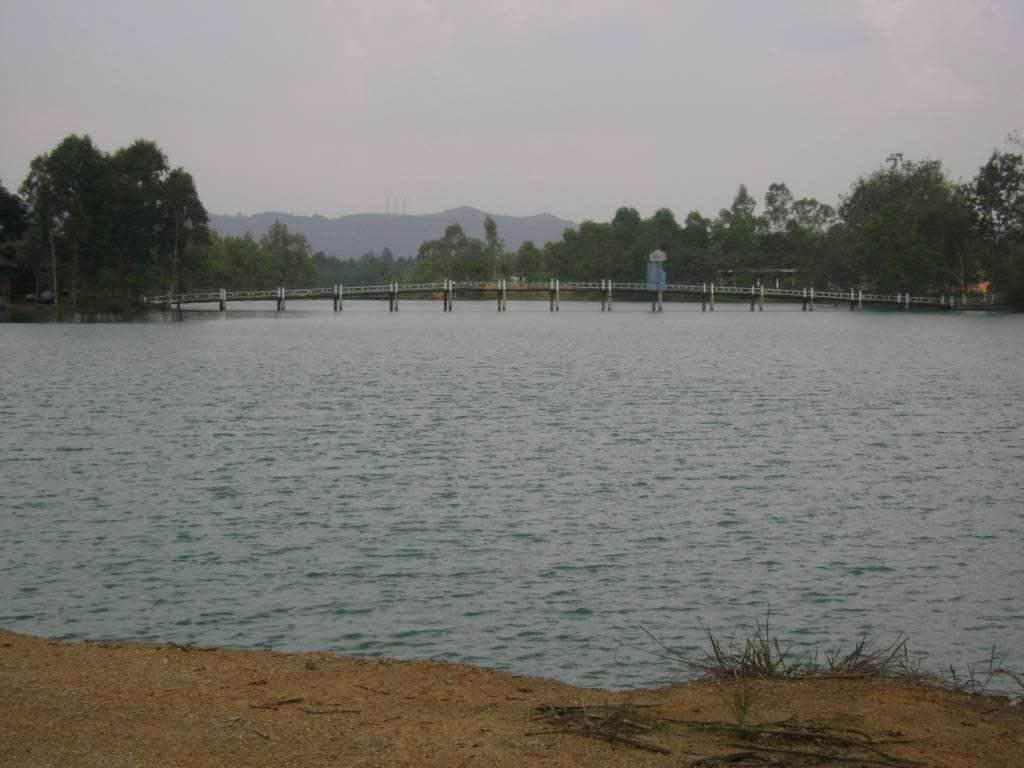
Ecotourism Site of Duy Son II hydroelectricity - Photo: phuot.vn
Ecotourism Site of Duy Son II hydroelectricity locates in Duy Son commune - Duy Xuyen district., and is 5 km South of Tra Kieu imperial city.
11. Thuan Tinh Ecological Tourism Zone
Located in the river islet with the area of 50 hectares, Thuan Tinh looks like a buoy floating at the lower section of Thu Bon river. Thuan Tinh is a typical ecological tourism zone in Hoi An town. Arriving here, tourists will enjoy the poetic natural landscapes. Under the green nipa and willow forests howling in the wind, tourist can row a boat on river or take part in the folk games, go fishing, watch water puppet performance or contemplating handicrafts and fine arts displayed in the ancient house with typical Vietnamese countryside style.. Tourists can also go camping, enjoy reading and picnic under the shadow of tree leaves or relax in the bungalows well-equiped with facilities.
Thuan Tinh Ecotourism Zone - Photo: toibay.vn
With a distance of 3 kilometres from Hoi An ancient town, tourists will find it is very convenient to travel by land or river from Hoi An to here.
12. Suoi Tien (Fairy Spring)
Suoi Tien Spring is located in Que Phu commune - Que Son district, 15 kilometres from Huong An cross road along the provincial road No. 611 to the West. Suoi Tien is related to the legend of male deities and a woodsman that passionately playing chess.
Suoi Tien - Photo: dulich - hoian.net
Suoi Tien Spring is an ideal tourist attraction including 14 waterfall chains flowing slowly in the middle of the superb forest, like a fairyland scene. In the riverhead, from 400 meters high, the stream falls down to the large rocks making to the white spume and the vivid constant sound at whispers roaring in the large forest. Apart from seeing the beautiful landscape and being in the water of the cool pond, tourists can visit the vestige of the Vanguard Youth Women Ba Thao battalion standing by the waterfall in struggle against the Imperialists.
13. Mineral Water resource of Tay Vien
Many local people think that Tay Vien is a herbal remedy garden located in the West of Que Son district because there are many kinds of precious aloe wood and medicinal plants here. Another tale relates that Tay Vien is a place of poetic landscapes like a fairyland paradise in the west.
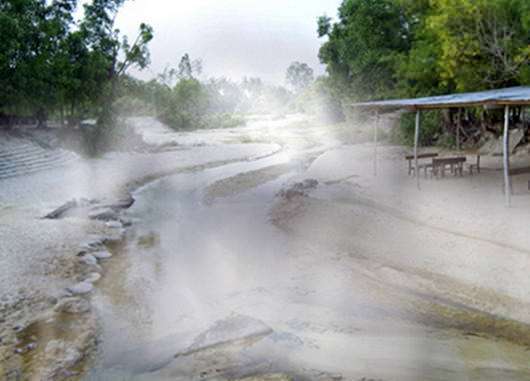 Mineral Water Resource of Tay Vien - Photo: thapbahospring.com.vn
Mineral Water Resource of Tay Vien - Photo: thapbahospring.com.vn
From Dong Phu town (Que Son Dist.,) to Trung Phuoc Hamlet passing spectacular Le pass on the small field of Que Loc district, tourists will see two mineral water pits always boiling. That is Tay Vien mineral water which the local people call the Ong (sir) and Ba (madam) pits, flowing from Hon Tau Mountain. It always has a big capacity, with the stable temperature of approximately 800C. Thanks to high mineral content, and poetic natural scenery, Tay Vien will become an ideal tourism spot in the small areas in the West of Quang Nam. From Tay Vien, tourists can walk or ride bicycles along the path throughout the mountain to My Son Sanctuary - the World Culture Heritage in 3 hours.
14. Khe Lim
From Ai Nghia, Dai Loc district, travelling along National highway 14B of 20 km to the West, tourists will reach Khe Lim landscape spot. In the long distance, the waterfall looks like a thin veil, sometimes appearing and disappearing, catching our eyes between the vast of forests and making us suddenly thinking about Cam Ly waterfall Da Lat dreamlike city. From Am Thong mountain-top, a large stream which is nearly 20 meters high, falls down, roaring to the spring all day with a lots of rocks heaped up creating the waterfalls which flow slowly to Vu Gia river and flowing to the immense sea. Along two sides of the spring are virgin forests and floristic composition growing green all year around. Together with the Hio-Hiu mountain range in the south and hill ranges going up and down in the northwest, there are harmonious scenery picture. On the top of the waterfall in Khe Lim there is a vestige of Chua Am (Am pagoda) with mysterious anecdotes.
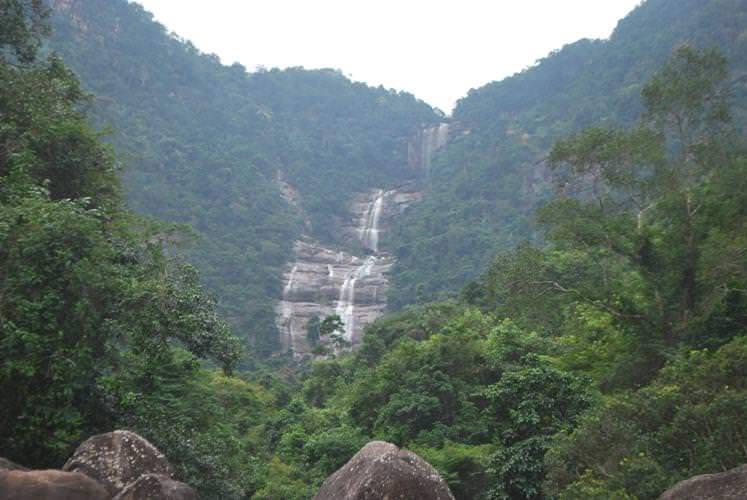
Khe Lim - Photo: dailocrt.vn
15. Giang Thom Pit
10 kilometers from National Road 1 to the west of Nui Thanh district., Giang Thom Pit is a beautiful landscape in Quang Nam province. Tourists feel free from any tiring by hearing vivid sounds of springs and waterfalls. From afar, the riverhead falls down the large rock making the beautiful attraction of the waterfalls. At the foot of the fall, the stream flows making many deep holes with blue water a small mirror reflecting the scenery. Giang Thom Pit is covered by clouds and dew creating a harmonious scenery picture showing a pure and primitive beauty distracting tourists’ minds.
Giang Thom Pit - Photo: wikivietnam.net
Giang Thom Pit is really an ideal landscape for ecotourism and excursions. Herein, people who like thrills can climbing up to rough rocks to conquer high waterfalls. The riverhead with the green ponds and quiet scenery are suitable for tourists who enjoy quiet and poetic scenery of the wild nature.
16. National Park of Song Thanh
Located on the border of Nam Giang and Phuoc Son district, near the border of People Republic of Laos with the large area of approximately 93,429 hectares of sunken zone and 108,398 hectares of buffer zone. The sunken zone is divided into two areas: strictly preserving zone of 75,373 hectares and ecological rehabilitating zone of 17,512 hectares.
This place has a lots of wonderful things, attracting tourists and scientists by plentiful natural resources. There are totally 831 species of plants recorded in the survey in 1997 and 1999 carried out by WWF- Indochina and Institute of Vietnam Investigation Projecting Forest. Among these species, there are 23 useful species, 38 species recorded in Red Book of Viet Nam. The forest fauna here is various with 53 species of animal, 183 species of bird, 44 species of reptile, 21 species of amphibian and 25 species of fish.... The result of the investigation showing that here there are many precious animals such as tiger, panther, elephant, etc. Tourists can contemplate the Grang waterfall, Thac Nuoc (waterfall) bridge and beautiful landscapes along Ho Chi Minh legend Trail or discover specific characteristics of ethnic minorities’s cultures.
17. Traditional Occupation Villages
In the early of 15th - 16th centuries, the handicrafts had been found by immigrants from the Northern setting up in the Southern and vigorous development in Quang Nam land. Passing the hundreds year of rising and falling, Quang Nam occupation villages still remain the tradition from father to son. In the brilliant past, the products of occupation villages had not only served daily life but also presented in international area such as: Kim Bong Carpentry, Thanh Ha Pottery, Phuoc Kieu Bronze Casting, Ma Chau Silk Weaving etc. They altogether had made a part of Hoi An features where used to be the busiest port in the last century like Hue capital into the ancient and full fascinating town.
Thanh Ha Pottery Village
Location: Cam Ha Commune, Hoi An ciy
This pottery trade of this village is believed to originate from Thanh Hoa Province. From clay as main raw material, the clever hands of artisans create pottery products for domestic use, such as bowls, jars, vases, ornament tree pots, with a variety of shapes and colors, and with great durability. These pottery products are on display and on sale at souvenir shops and are very popular with visitors.
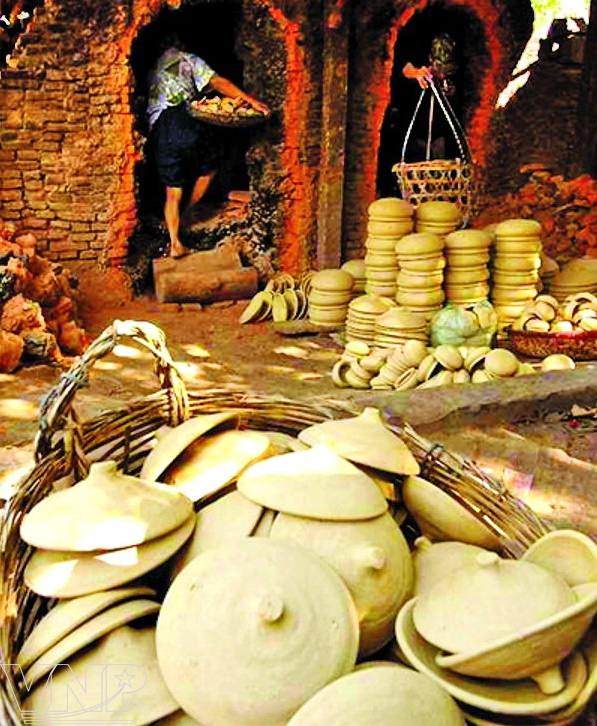
Thanh Ha Pottery Village - Photo: vietnam.vnanet.vn
Visiting this trade village, you will not only indulge yourselves in shopping a variety of souvenir items, but also will be able to see with your own eyes the stages in the making of these products.
Kim Bong Carpenter Village
Location: Cam Kim Commune, Hoi An city
Kim Bong Carpenter Village - Photo: baotinnhanh.vn
The carpentry of this village is believed to originate from North Vietnam, and has long been famous with its arts of wood carving and sculpture. Through contact and exchange with artisans of the same trade from Chiem Thanh, China, Japan and so on, combined with their own skills, these Kim Bong carpenters have created pieces of work which have normally great meaning in philosophy and fine arts. Products made here have been marketed in domestic as well as oversea markets.
Tra Que vegetable Village
It is far from Hoi An old town 2 kms to the Northeast. Its location is between De Vong river and Tra Que alga pond (Cam Ha commune - Hoi An city). This village is famous for many kinds of vegetables in a long time: lettuce, houttuynia, flagrant knoutwed, basil and coriander vegetables etc., and It is usually used in the Quang Nam special foods: Hoi An vermicelli, Quang soft noodle soup, dry pancake roll with pork…
Tra Que Vegetable Village - Photo: tttd.vn
With the area approximately tens of hectares of cultivated land but vegetable planting occupation had become the main occupation of native people from generation to generation. It developed the best prosperously since Hoi An tourism started to get gorgeous achievements.
Now, besides vegetable planting to supply for restaurants and wholesales markets in Quang Nam province as well as in Da Nang city with income up to billions of VND each year. Tra Que people also participate in tourism activities, tourists come here not only being guided to make soil, fertile, grow vegetable but also learn how to make the cuisine from vegetables in this place like the native people.
Phuoc Kieu Bronze Casting Village
Location: Dien Phuong Commune, Dien Ban District
Some of the products made by this village are bells, gongs, gong-like music instruments, incense burners, lamp holders, ancient vases, and other bronze musical instruments which are normally used in festivals, ceremonies and everyday life.
These musical instruments can give out unique sounds due to special techniques of combination of different types of metals in the process of casting which only the skilled artisans can do.
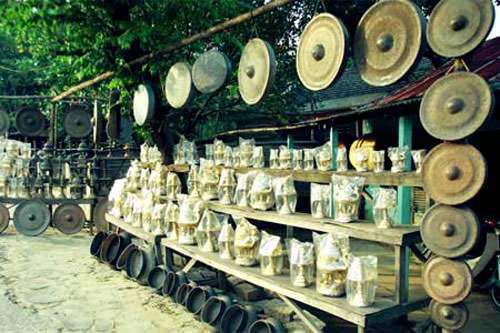
Phuoc Kieu Bronze Casting Village - Photo: vanghe.blogspot.com
Ma Chau Weaving Village
It was founded in 15th century and located closely to Tra Kieu, Ma Chau village only wove silk and supplied for aristocrats, mandarin classes in the court. The stages of growing silkworms, breeding, unraveling silkworm cocoons and weaving were made by hundreds of householders in village following to craft methods.
Ma Chau Weaving Village - Photo: dantri.com.vn
When the government in the south of Viet Nam opened the gate to exchange trade to the world through Hoi An port so Ma Chau silk was the most exported goods. At the end of 19th century, when the French arrived in Viet Nam and herein, there was more floriculture and weaving occupations but silk was the main product to be used. In this period, means of production in village was remarkably improved from using wooden looms to half-machine, then reaching automation now.
Today, Ma Chau weaving village has specific characteristics in rural villages of Viet Nam with many green tree gardens, tea and areca palm hedges... Especially, the hospitality of native people will make tourists satisfied when arriving here.
Its location is in Chau Hiep hamlet - Nam Phuoc town, 3 kms far from center of Duy Xuyen district to the East, and on the way to My Son Sanctuary.
Dong Yen - Thi Lai Mulberry Silkworm Village
Like Ma Chau weaving village, in the last centuries, Dong Yen - Lai Chau villages had the reputation of growing silkworms, unraveling cocoons and weaving. Popular products include: Satin, tussore, chiffon and mattresses, which used to be exported to the far east by foreign trader ships. In its hey day, this village grew more than 160 hectares of mulberries and nearly 200 households participated in producing silk by handicraft methods, the craftsmen in Dong Yen - Thi Lai emigrated to settle down in Southern and found the weaving village with the large scale such as Bay Hien, Go Vap in Ho Chi Minh city nowadays.
Ban Thach Mat Village
From Nam Phuoc town - Duy Xuyen district to the East of about 5 kms, tourists will see the green groves of jute along the bank of Thu Bon River.
This is a major raw material to make the mat product of Ban Thach village. The exquisite and clever hands of Ban Thach women make simple threads of segde bright,soft & solid mats with multicolor & kinds which are favoured by the domestic market.
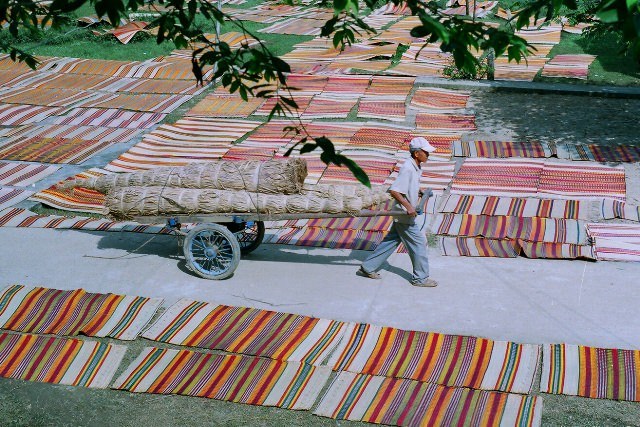
Ban Thach Mat Village - Photo: dulichhoiancungmytour.blogspot.com
Thanks to the location in the water area in Tra Nhieu and has poetic natural landscapes, Ban Thach is becoming an attractive destination for tourists who like discovering the traditional occupation villages in Quang Nam.
Ban Thach is located in Duy Vinh commune - Duy Xuyen district.
Brocade Weaving Occupation Of Cotu Ethnic
Although it has not developed as an occupation village yet but brocade weaving occupation had become the traditional village baring the deep cultural characteristics of Cotu ethnic. With the skillful hand of Cotu women, they had changed the homemade materials into the products such as blankets, loincloths, skirts, etc with multiform color and unique vignettes. The stage of weaving is made entirely by hand-made method, from growing material (cotton, jute, flax, etc) to finishing the products. As for brocade weaving, the Cotu women have to work hard during many days or a month to accomplish product entirely.
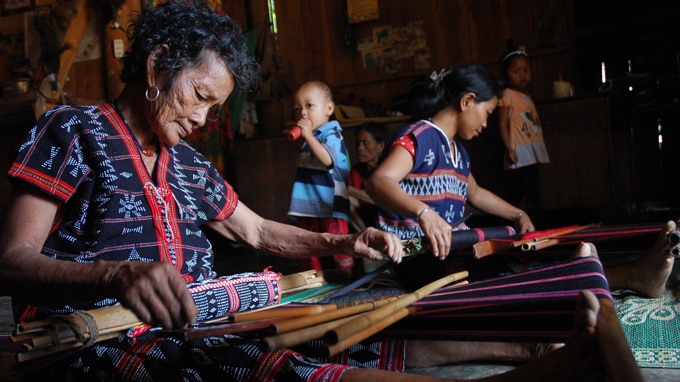
Brocade Weaving Occupation Of Cotu Ethnic - Photo: vnhotels.vn
Brocade weaving occupation still retains the traditional characteristics of Cotu ethnic minority in village but gathers mainly in Tabhing (far 15 kms from Thanh My - Nam Giang district to the North-West). Herein, tourists will be exciting when being taught heartily by Cotu women to weave brocade products with simple looms that it was made from bamboo and wood.
Source: The Internet